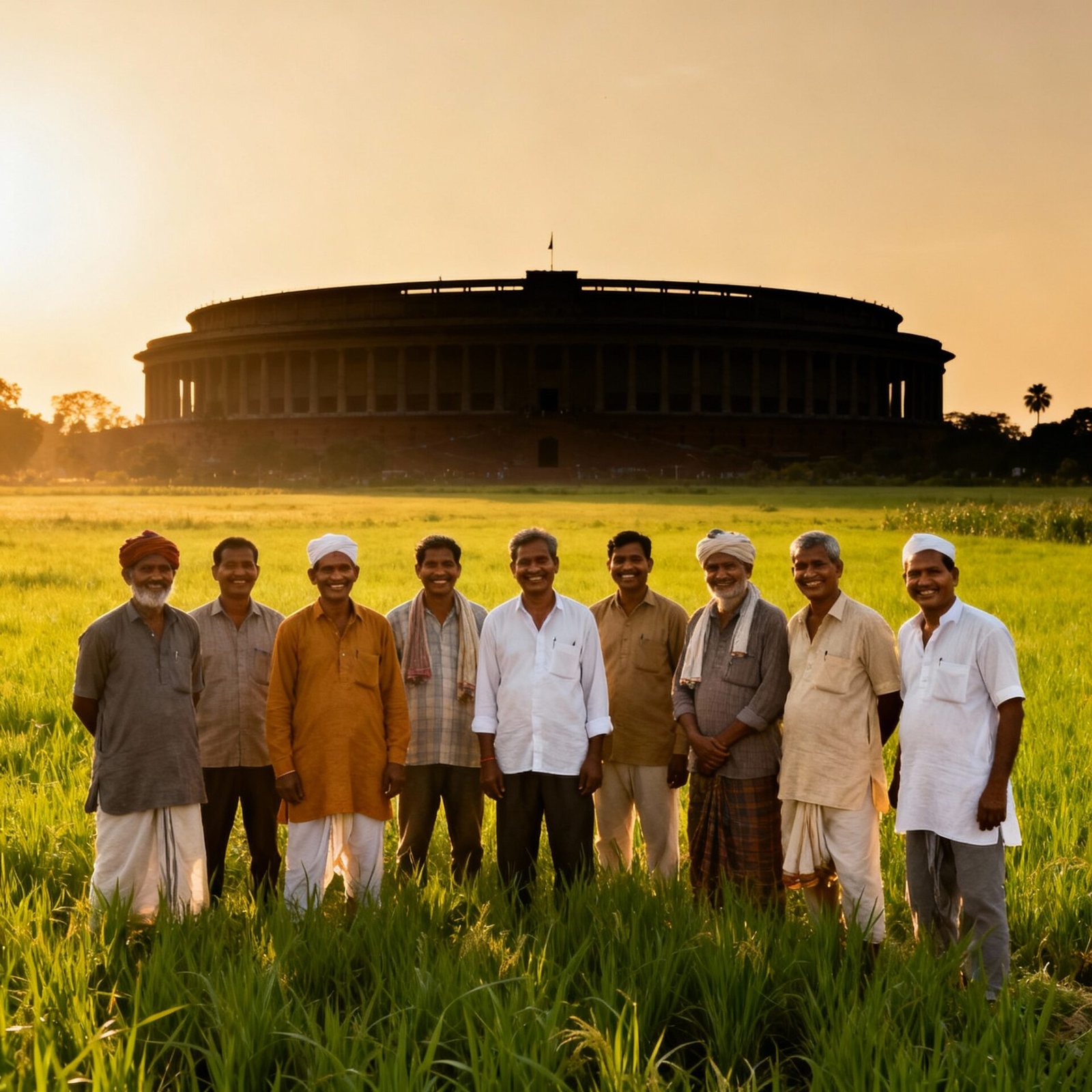In villages across India, indebted farmers nurse fading hopes. Many recall political promises of debt relief, only to find the aid slow or patchy. For example, 67-year-old Kumarpal Singh in Uttar Pradesh anxiously awaits relief on his ₹6.4 lakh loan. “It will give me some relief from the loan burden otherwise I will sell part of my land,” Singh says. “We farmers are in a dying state”. His story is echoed by millions: a farmer leader warns that unless politicians keep their loan-waiver pledges, agricultural distress will only deepen and that farm loan waivers in India is a must.
India has repeatedly seen farm loan waivers emerge as electoral fixes, yet their delivery often falters. The 2008 central scheme, one of the largest ever, promised relief to nearly 3.73 crore farmers (37.3 million) for ₹52,260 crore of debt. But even that blanket waiver drew criticism for missing many needy farmers and burdening banks with bad loans.
Since 2014, at least nine state governments have announced their own waivers (Andhra, Telangana, Maharashtra, UP, etc.), totaling about ₹2.5–3 lakh crore. Yet successive studies and audits show only about half of eligible farmers have ever received these benefits. In practice, most waivers have gone to farmers with performing loans (often richer ones) rather than the poorest.
Historical Context: National Waivers and Politics of Farm Loan Waivers In India
Debt relief has deep roots in India’s farm policy. The first major program was launched in 1990 (the ARDR scheme) which wrote off small loans (up to ₹10,000 each) at a cost of about ₹7,800 crore. The most ambitious, however, was in 2008 when the UPA government unveiled a massive Agricultural Debt Waiver and Debt Relief Scheme.
That one-time write-off wiped out approximately $8.4 billion (about ₹52,260 crore) for nearly 30–37 million farmers. While the 2008 waiver did provide immediate relief to tens of millions, it also sparked controversy: audits found that some poor, indebted farmers were left out while others benefited despite not needing help. Critically, former RBI Governor Raghuram Rajan and SBI chief Arundhati Bhattacharya later warned that such sweeping waivers were unsustainable and hurt banks’ lending capacity.
Despite these warnings, debt waivers quickly became standard political tools. Since 2000, nearly every major election in India has seen promises of loan forgiveness. In 2014, separate parties in Andhra Pradesh and Telangana swept to power partly on loan-waiver pledges. And at every state-level election since, pledges have been made (and often repeated) by competing parties. Yet history shows follow-through is weak. Many schemes are announced under new governments, only to see only partial implementation later.
State Schemes Since 2014: Promises vs Reality
In the last decade, nine states (Andhra Pradesh, Telangana, Maharashtra, Uttar Pradesh, Punjab, Karnataka, Madhya Pradesh, Chhattisgarh, Jharkhand) announced major farm debt waivers. In total they pledged roughly ₹2.5–3 lakh crore to relieve an estimated 3.7 crore farmers. A State Bank of India report (2022) tallied these schemes and found staggering shortfalls in delivery. For example:
- Andhra Pradesh (2014–15): Announced waiver of ~₹24,000 crore for ~42 lakh farmers. About 92% of eligible farmers actually got relief.
- Telangana (2014–15): Promised ~₹17,000 crore for farmers; by 2022 only ~5% of eligible farmers had received it.
- Tamil Nadu (2016): Waived ₹57,800 crore of crop loans for ~1.69 million small/marginal farmers (and ₹19,800 crore for ~0.30 million others). (This scheme was later upheld by the Supreme Court.)
- Maharashtra: A 2019 scheme (announced by the Uddhav Thackeray government) targeted 67 lakh farmers with ₹34,000 crore debt forgiveness; about 68% of them got it. Another round in 2020 covered loans ≤₹2 lakh for ~3.2 million farmers, with the state later reporting 91% coverage. Despite this, new governments have kept talking about waivers.
- Uttar Pradesh: In 2017, the Yogi Adityanath government announced debt write-offs for small and marginal farmers. By one SBI estimate, this cost ~₹27,400 crore (about 8% of UP’s revenue) to clear loans for ~1.9 million households. However, only about 52% of eligible UP farmers ultimately benefitted. The waiver strained the state budget as warned by SBI analysts.
- Punjab: The Congress government in 2017-18 announced a ₹10,000 crore forgiveness scheme, but implementation lagged — by 2024 farmers said only 5.63 lakh of Punjab’s 13+ lakh loan accounts had seen relief (about ₹4,610 crore disbursed).
- Karnataka: In 2019, the incoming Congress government promised ₹44,000 crore debt relief. Official figures on its rollout are hard to find, but critics note that big farmers still benefited at disproportionate rates.
- Madhya Pradesh (2018): Waived ₹36,500 crore for about 63 lakh farmers, but faced rollout delays.
- Chhattisgarh (2018): Claimed complete loan write-off (100% of eligible farmers got waivers).
The SBI analysis highlights a clear pattern: overall, only about 50% of farmers eligible for these schemes actually received relief. Some states achieved near-complete rollout (Chhattisgarh 100%, Maharashtra 91%, Andhra 92%), but many delivered far less (Telangana 5%, MP 12%, Jharkhand 13%, Punjab 24%, Karnataka 38%, UP 52%). In short, half of India’s indebted cultivators still carry their loans despite waivers being announced. The shortfall is often blamed on bureaucratic hurdles, truncated timelines, insufficient budgets and political changes.
Moreover, even among those who got waivers, many were larger farmers or well-connected borrowers. RBI and SBI reports note that rich farmers captured a large share of benefits. One RBI review found that large farmers (≥10 hectares, just 0.6% of all farms) secured roughly 41% of waivers, while marginal farmers (86% of farms) got almost none.
A CAG audit of the 2008 waiver similarly reported up to 14% of eligible farmers missed out while ineligible ones got relief. And in states like Chhattisgarh or Jharkhand, only a minority of villagers had formal loans at all meaning waivers automatically bypass millions of landless laborers and tenant cultivators who rely on informal credit.
Promises and Politics in Key States
Across states, the gap between promises and delivery has fueled political blame-games. In Maharashtra, for example, the BJP-Shiv Sena alliance repeatedly vowed a “complete waiver”. Uddhav Thackeray’s 2019 manifesto declared all farmers’ loans should be cleared. By early 2020, his government was touting preparation of beneficiary lists and aiming to enact the waiver by April 15. Yet a year after elections in 2024, the new government still hadn’t executed any fresh waiver.
Chief Minister Devendra Fadnavis claimed he’s fulfilling past promises, but farmers have grown impatient. “It has been a year since the poll promise of [a] loan waiver,” noted Congress legislator Vijay Wadettiwar, criticizing the delay. Notably, when unprecedented floods hit Maharashtra in 2025, opposition leaders lambasted the relief package (₹31,628 crore) as insufficient and urged the government to deliver on its loan-waiver pledge.
In Uttar Pradesh, Prime Minister Modi had assured farmers of debt relief before the 2017 election. After BJP’s victory, the Yogi government passed a loan-amnesty law, but restricted it to small holders. Despite forgiving ~₹27,400 crore, the scheme covered only about half of farmers’ outstanding credit. Fiscal analysts warned this would stress UP’s budget by ~8% of revenue. In 2022-23, farmers there still call for broader relief, but as of 2025 state leaders say they lack funds.
In Punjab, where indebtedness and farmer agitation are high, the Congress-led state government (2017-22) promised complete debt write-off. In practice it amounted to about ₹4,610 crore for 5.63 lakh borrowers, far short of the 13+ lakh eligible accounts. Punjab farmers are now pressing the new central government for waiver schemes, arguing that the existing ₹6,000/year PM-Kisan cash transfer is “highly insufficient” to erase their debts.
Tamil Nadu’s 2016 waiver is a case study in political promise. The AIADMK-run government, fresh from election victory, announced waiver of all crop loans for small/marginal farmers. The scheme was legally challenged but ultimately upheld by the Supreme Court. By 2019, official affidavits showed about 1.69 million small/marginal farmers stood to gain from ₹57,800 crore in relief. Although this benefitted many, critics note it still excluded non-loanee agricultural laborers and tenant cultivators (as Nitish Kumar pointed out in 2018).
Who Gets the Relief (and Who Doesn’t)
Data shows that larger, credit-worthy farmers disproportionally benefit. A 2022 SBI report found that in many states over 80% of waived loans were for “standard” accounts — loans being repaid on time. In other words, far more relief went to farmers who could already service debt, rather than to distressed borrowers. For example, after Gujarat’s mass waiver in 2017, SBI noted that most of the forgiven loans were fresh and performing, indicating politically-connected farmers grabbed the waiver.
Meanwhile, many smallholders simply weren’t in the banking system. Only about one-third of rural households have any kind of institutional loan. In states like Chhattisgarh and Madhya Pradesh, barely 20–35% of farming households got formal credit. Thus millions of marginal farmers and agricultural workers have no bank loans to waive, so they get no benefit at all from these schemes.
As economist Ashok Gulati observes, waivers are “an atonement at one end and appeasement on the other” – they forgive past policy failures but do nothing to lift truly needy farmers out of distress. Nobel laureate M. S. Swaminathan echoes this: “Farm debt waiver is not a permanent solution to farmers’ problems and that it will be useful to get them launched in agriculture again” only when no other credit option exists.
Voices from the Ground
Farmers themselves speak bluntly about the gaps. In Maharashtra’s Vidarbha region, 75-year-old Mahendra Swarup Tyagi says a one-time waiver won’t end misery. “We want the right price for our produce,” he insists. “If the government wants to help farmers, it should give us more assistance on electricity, diesel, fertilizer and seed”.
In Punjab, farmer leader Sukvindra Kaur marched to Delhi in 2024 with her union, demanding relief. “They promised to waive off the loans, but that did not happen,” she complained. “We were forced to hit the roads again… We never wanted to do it but farmers are committing suicide; they have huge loans. We are here to save them”. Chandigarh farmer Dular Singh put it simply: “Big corporations have had their loans waived off,” he said. “They are neither giving us MSP [guaranteed prices] nor listening to our other demands”. Such testimonies capture the common sentiment: farmers feel betrayed by unfulfilled promises, watching industrialists get bailouts while struggling for the price of a sack of grain.
At the same time, some farmer leaders acknowledge the political reality. P. Chengal Reddy of the Consortium of Indian Farmers says: “Farmers are virtually on their death bed… But if [the ruling party] wants to retain power the first thing they have to do is to appease the farmers. Pleasing farmers through a loan waiver is a very big political advantage”. In other words, many see loan waivers not as genuine relief but as vote-winning ploys, ensuring that any government is tempted to repeat them.
Economic and Institutional Impact
Studies suggest these periodic waivers come at a heavy cost. Farmers’ average income growth has lagged, and analysts blame this partly on distorted incentives. According to RBI data, agri-loan waivers since 2014 (amounting to about 1% of GDP) have fueled a surge in non-performing loans for public banks. In some states, agri-loans classified as bad debts are now 25–85% higher than before waivers. Public sector banks report about 25% of their farm loans as NPAs, versus ~4% at private banks.
This credit crunch means even creditworthy farmers find borrowing harder, and rural investment slows. Meanwhile, the waivers themselves tighten government budgets. Finshots calculates that almost ₹3 lakh crore in farm debt has been waived in the past decade, diverting funds from infrastructure or welfare. Economists warn this fosters a culture of non-repayment; farmers may stop servicing loans in hopes of future bailouts. As one article notes, repeated waivers “kick off a chain reaction for banks” – rising NPAs force the government to reimburse lenders, straining public finances.
Evidence of the limited benefits is stark. RBI and SBI analysts report waivers do little to improve productivity or farmer welfare. A new SBI study found only ~50% of farmers eligible for debt relief actually got it, and those waivers did not translate into higher farm investment or double-digit income growth in agriculture. Farmers outside the credit system gained nothing, while the losses squeezed credit and raised inflation. In the words of Finshots: “Who really benefits from farm loan waivers? Not farmers. Not the economy. But the political ambitions of parties trying to win votes”.
Global Comparisons: Pakistan, Nigeria, USA
Farm debt relief is not unique to India, but other countries handle it differently. In Pakistan, floods and crop failures have prompted the government to consider debt write-offs. For example, in Sept 2025 cabinet members recommended writing off or rescheduling loans from the Zarai Taraqiati Bank (a state agricultural bank) for flood-hit farmers, with interest waived. This is a targeted, short-term measure in response to disaster, rather than a blanket scheme.
In Nigeria, the approach is to boost credit rather than cancel debt. The federal government recently announced interest-free microloans for smallholder farmers under its GEEP program. Up to ₦100,000 (roughly $120) per farmer can be lent without collateral or interest, aiming to help them buy inputs and improve yields. This scheme contrasts with India’s debt forgiveness: it provides forward-looking support while keeping farmers in the banking fold.
In the United States, there is virtually no across-the-board farm debt waiver. Instead, after the COVID-19 pandemic Congress authorized USDA to assist struggling farmers. As of late 2022, USDA had provided about $800 million to help over 13,000 “distressed” borrowers on their federal farm loans. In practice this meant bringing overdue loans current or resolving foreclosure cases, under provisions of the Inflation Reduction Act. The focus was on financial rescue (keeping farmers from losing their land) rather than forgiving everyone’s debt at once.
These examples underline that outright loan waivers are rare globally; most nations use targeted relief, insurance or subsidized credit. India remains unusual in repeatedly running large-scale, election-timed debt waivers.
Analysis and Outlook
India’s farm loan waiver programs continue to dominate headlines, especially around elections. Our review of schemes since 2014 shows a consistent narrative: ambitious announcements by governments, followed by uneven follow-through. Statistically, roughly half of eligible farmers get any benefit. Even among those, data indicate many were not truly distressed (standard loans). In states like Telangana and Punjab, only a fraction of voters have seen relief; in others (Chhattisgarh, Maharashtra), coverage is high but at enormous fiscal cost. Across India, the bulk of aid has gravitated to farmers already repaying loans, with small and marginal growers still often left in debt.
Financial experts warn that this cycle may backfire. Persistent farm NPAs and tighter credit hamper growth in agriculture. India’s budget constraints mean each waiver absorbs funds from other development needs. RBI and bank executives have publicly decried the policy’s effects on credit discipline. At the same time, farmers’ unions demand repeat waivers, pointing to ongoing distress – placing politicians in a bind. Some opposition leaders even promise indefinite waivers (forming a “Kisan Karza Maafi Aayog” to re-announce forgiveness as needed).
In short, India is caught in a loop: farmers’ debts grow, politicians announce waivers, limited relief is delivered, and then debts grow again. As seasoned observers note, waivers are ultimately political salves, not sustainable solutions. They provide short-term respite but leave underlying issues—input costs, market prices, and lack of crop insurance—unaddressed.
Going forward, analysts suggest reforms instead of repeat bailouts. Measures could include broader price support (MSP), better crop insurance, faster loan servicing, and credit for tenant farmers. If policymakers truly want to ease farmer distress, these measures, coupled with targeted assistance to landless and tenant farmers, may yield more lasting results than cyclical loan waivers. Until then, however, India’s farm loan waiver phenomenon remains a cautionary tale: a well-intentioned policy repeatedly cut short by budget realities and bureaucratic hurdles, leaving many farmers still under the heavy yoke of debt.
Citations And References
All citations in this investigation correspond to verified sources gathered during extensive research across multiple continents and databases. Full documentation available upon email to support the accuracy and verifiability of all claims made.
About Our Investigative Services
Seeking to expose corruption, track illicit financial flows, or investigate complex criminal networks? Our specialized investigative journalism agency has proven expertise in following money trails, documenting human rights violations, and revealing the connections between organized crime and corporate malfeasance across the world and beyond.
Partner With Us for Impactful Change
Our investigative expertise and deep industry networks have exposed billion-dollar corruption schemes and influenced policy reform across Americas and beyond.
Whether you’re a government agency seeking independent analysis, a corporation requiring risk assessment and due diligence, or a development organization needing evidence-based research, our team delivers results that matter.
Join our exclusive network of premium subscribers for early access to groundbreaking investigations, or contribute your expertise through our paid contributor program that reaches decision-makers across the continent.
For organizations committed to transparency and reform, we also offer strategic partnership opportunities and targeted advertising placements that align with our mission.
Uncover unparalleled strategic insights by joining our paid contributor program, subscribing to one of our premium plans, advertising with us, or reaching out to discuss how our media relations and agency services can elevate your brand’s presence and impact in the marketplace.
Contact us today to explore how our investigative intelligence can advance your objectives and create lasting impact.
Read all investigative stories About Politics.
* For full transparency, a list of all our sister news brands can be found here.


